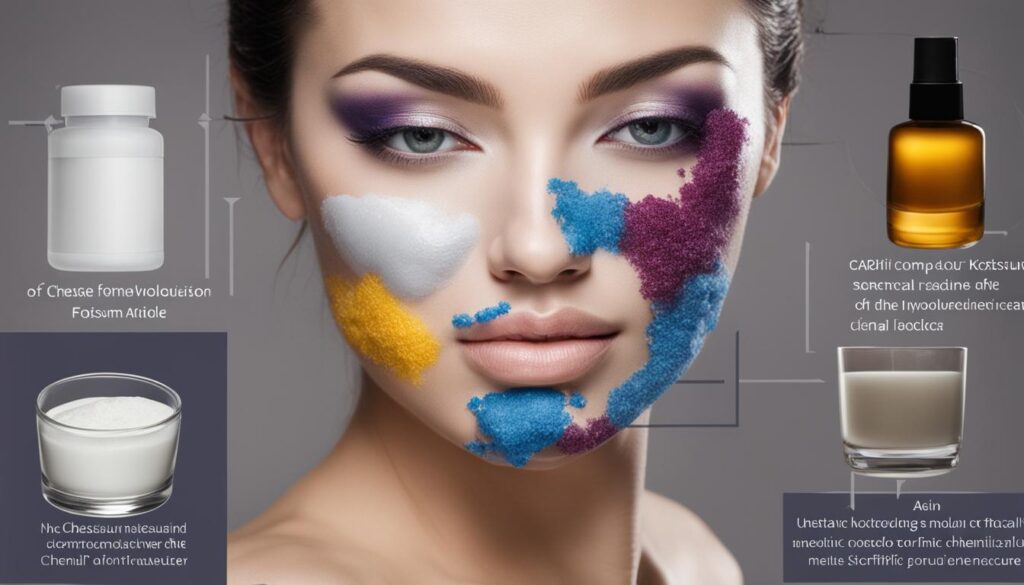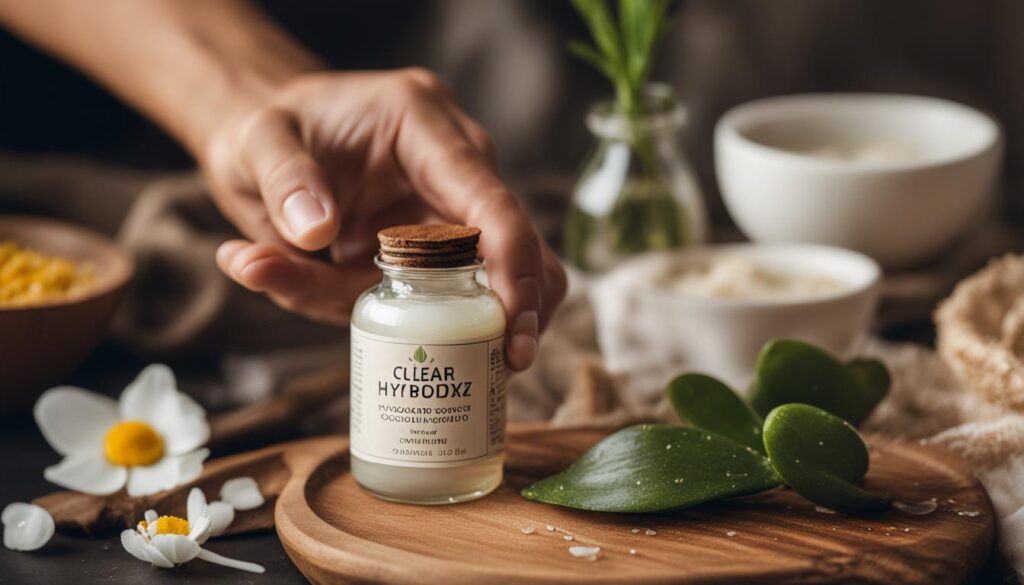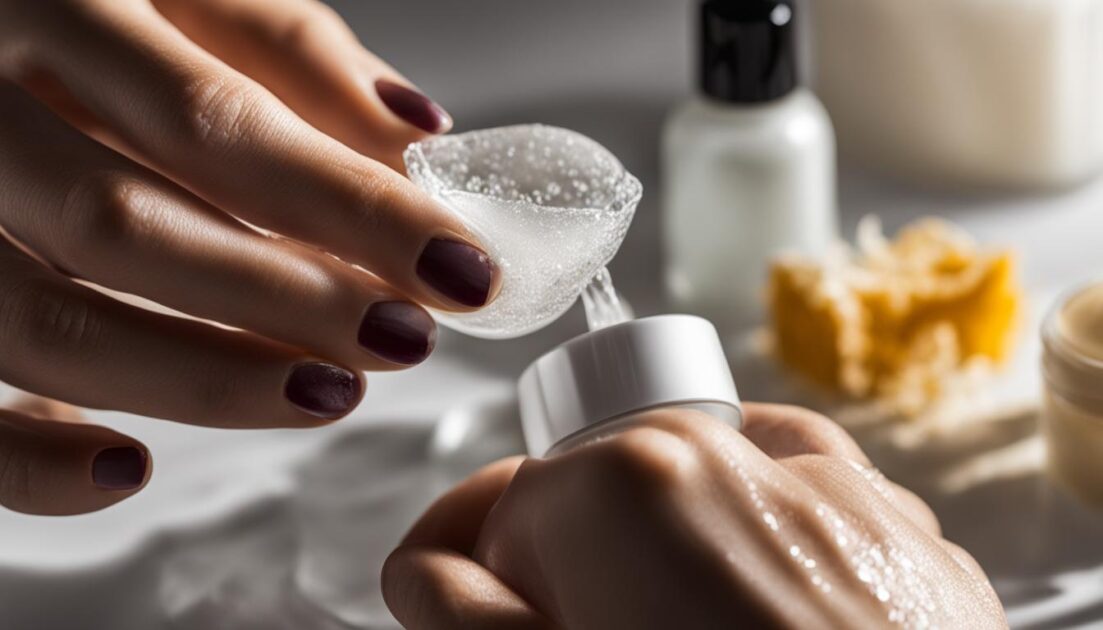Welcome to my article on the use of potassium hydroxide in skincare. Potassium hydroxide, also known as caustic potash, is a chemical compound commonly found in various skincare products. It serves a vital role in maintaining the pH balance of these products to ensure they are gentle and effective for the skin.
Skincare products containing potassium hydroxide, such as facial cleansers, moisturizers, masks, and serums, aim to stabilize the pH and prevent disruption to the skin’s natural acid mantle. When the pH of skincare products is too acidic or too basic, it can lead to skin imbalances and potential irritation.
However, it’s important to note that high concentrations of potassium hydroxide can be harsh on the skin and may cause irritation and sensitivity. Therefore, it is crucial to use products with appropriate concentrations of potassium hydroxide to avoid any negative effects.
Key Takeaways:
- Potassium hydroxide is used in skincare products to stabilize their pH and protect the skin’s acid mantle.
- Using products with appropriate concentrations of potassium hydroxide is essential to avoid skin irritation and sensitivity.
- Skincare formulations with potassium hydroxide help maintain the skin’s natural acid mantle, protecting it from bacteria and pollutants.
- While generally safe, high concentrations and prolonged use of potassium hydroxide can lead to cumulative damage to the skin.
- Follow recommended concentration limitations and handling guidelines for safe use of potassium hydroxide in skincare products.
Potassium Hydroxide in Skincare Formulations
Potassium hydroxide plays a crucial role in skincare formulations as it helps stabilize the pH of the products. The pH of a skincare product is important to maintain the skin’s natural acid mantle, which protects it from bacteria, pollutants, and allergens. If the pH of a product is too acidic or too basic, it can disrupt the acid mantle and lead to various skin issues.
Potassium hydroxide ensures that the pH of skincare products is within the ideal range to maintain the health and integrity of the skin. By stabilizing the pH, potassium hydroxide helps to optimize the effectiveness of other active ingredients in the formulation, allowing them to work more efficiently.

Moreover, potassium hydroxide facilitates emulsification, helping to blend oil and water-based ingredients together in formulations. This contributes to the desirable texture and consistency of skincare products.
When used in proper concentrations, potassium hydroxide poses minimal risk to the skin and can be safely incorporated into skincare products. However, it is crucial for formulators to follow strict guidelines and adhere to recommended usage levels to avoid any potential irritation or damage to the skin.
Function of Potassium Hydroxide in Skincare
Potassium hydroxide acts as a pH adjuster in skincare formulations, ensuring that the final product falls within the optimal pH range for the skin. This is important because the skin’s acid mantle functions best when the pH is slightly acidic, typically between 4.5 and 5.5.
By stabilizing the pH, potassium hydroxide helps to prevent the disruption of the skin’s natural acid mantle, maintaining its protective barrier and reducing the risk of bacterial growth and inflammation.
Additionally, potassium hydroxide aids in the solubilization of certain ingredients, improving their bioavailability and enhancing their effectiveness on the skin. It assists in maintaining the overall stability and performance of skincare products, ensuring that they deliver the intended benefits to the skin.
In summary, potassium hydroxide plays a vital role in skincare formulations by stabilizing the pH, maintaining the skin’s acid mantle, and optimizing the performance of other ingredients. When used correctly, it is a valuable component in creating effective and safe skincare products.
| Benefits of Potassium Hydroxide in Skincare Formulations | Functions of Potassium Hydroxide in Skincare |
|---|---|
| Stabilizes the pH of skincare products | Adjusts the pH of formulations |
| Maintains the skin’s natural acid mantle | Facilitates emulsification of oil and water-based ingredients |
| Prevents disruption of the skin’s protective barrier | Aids in the solubilization of certain ingredients |
| Enhances the bioavailability of active ingredients | Improves stability and performance of skincare products |
Risks of Potassium Hydroxide in Skincare
While Potassium Hydroxide is generally considered safe for use in skincare products, high concentrations of it can cause skin irritation and sensitivity. Studies have shown that the use of alkaline cleansers containing Potassium Hydroxide can disrupt the skin’s natural bacterial flora composition and enzymes in the upper layers of the skin. Prolonged use of products with Potassium Hydroxide can lead to cumulative damage to the skin. It is important to use skincare products with appropriate concentrations of Potassium Hydroxide to avoid any adverse effects.
When used in high concentrations, Potassium Hydroxide can potentially cause irritation and damage to the skin. The alkaline nature of Potassium Hydroxide can disrupt the natural pH balance of the skin, leading to redness, dryness, and irritation. It can also disrupt the skin’s microbiome, negatively impacting the healthy bacteria that help maintain the skin’s barrier function.
The Irritating Effects of Potassium Hydroxide
Skin irritation from Potassium Hydroxide can manifest as redness, itching, burning sensations, and even rash-like symptoms. Individuals with sensitive skin are more prone to experiencing these effects. It is important to note that the severity of irritation can vary depending on the concentration of Potassium Hydroxide in the skincare product and the individual’s skin sensitivity.
In some cases, repeated exposure to Potassium Hydroxide can result in cumulative damage to the skin. The continuous disruption of the skin’s barrier function and microbiome can lead to compromised skin health and increased susceptibility to environmental factors. This can further contribute to conditions such as dryness, inflammation, and accelerated skin aging.
“When used in high concentrations, Potassium Hydroxide can potentially cause irritation and damage to the skin.”
Using Skincare Products with Potassium Hydroxide Safely
To minimize the risks associated with Potassium Hydroxide, it is essential to choose skincare products with appropriate concentrations of the ingredient. Look for products specifically formulated for your skin type and concerns, and always follow the instructions provided by the manufacturer.
If you have sensitive skin or a history of skin reactions, consider performing a patch test before incorporating a new product into your skincare routine. Apply a small amount of the product on your inner forearm and monitor for any adverse reactions such as redness, itching, or irritation.
It is also important to maintain a balanced skincare routine that includes products focused on hydration and barrier protection. This can help to counteract the potential drying effects of Potassium Hydroxide and support overall skin health.

By understanding the risks associated with Potassium Hydroxide and using skincare products containing this ingredient responsibly, you can minimize the potential for irritation and skin damage. Consult with a dermatologist or skincare professional if you have any concerns or questions about using products with Potassium Hydroxide.
Safe Use of Potassium Hydroxide in Skincare
Potassium Hydroxide is a commonly used ingredient in skincare and cosmetic products. When used within approved concentrations, it is considered safe for use by regulatory authorities. The US Food and Drug Administration (FDA) has classified Potassium Hydroxide as GRAS (Generally Recognized as Safe) for its use as a direct food additive, highlighting its long history of safe use.
However, it is important to note that concentrated Potassium Hydroxide can have corrosive and irritating effects on the skin, eyes, respiratory tract, and gastrointestinal system if ingested. To ensure the safe use of Potassium Hydroxide in skincare products, it is crucial to adhere to recommended concentration limitations and handling guidelines.
Skincare products containing Potassium Hydroxide should be formulated with appropriate concentrations to prevent any potential adverse reactions. It is always recommended to follow the usage instructions provided by the manufacturer and conduct a patch test before applying any new skincare product to the entire face or body.
“The safety of Potassium Hydroxide in skincare products lies in its correct formulation and proper usage. Users should always be mindful of concentration limitations and consult a dermatologist if they experience any adverse effects.”
When using skincare products that contain Potassium Hydroxide, it is essential to avoid contact with the eyes and mucous membranes. If accidental contact occurs, rinse thoroughly with water and seek medical attention if necessary.
Concentration Limitations of Potassium Hydroxide
The concentration of Potassium Hydroxide in skincare products should be within the approved limits to ensure safety. While specific concentration limitations may vary depending on the regulatory standards of different regions, manufacturers typically follow guidelines and restrictions provided by regulatory authorities such as the FDA or the European Union.
It is important for skincare product manufacturers to conduct thorough testing and adhere to these concentration limitations to ensure that the final product is safe for consumers. Regular quality control checks should be implemented to maintain consistency and compliance with regulatory standards.
| Regulatory Authority | Maximum Permitted Concentration of Potassium Hydroxide |
|---|---|
| US Food and Drug Administration (FDA) | Varies based on product type and application |
| European Union (EU) | Up to 5% in rinse-off products, up to 2% in leave-on products |
| Health Canada | Up to 5% in rinse-off products, up to 2% in leave-on products |
Note: The given concentration limitations are for illustrative purposes only and may not reflect the latest regulatory guidelines. It is advised to refer to the specific regulations of the respective authorities for precise and up-to-date information.

The safe use of Potassium Hydroxide in skincare products relies on manufacturers’ compliance with regulatory approvals and concentration limitations. By following proper handling guidelines and using products as directed, individuals can safely incorporate Potassium Hydroxide into their skincare routines while reaping its benefits.
Other Applications of Potassium Hydroxide
While Potassium Hydroxide is commonly known for its use in skincare products, it also finds numerous applications in various other industries. Its versatility as a chemical compound makes it valuable for different purposes beyond skincare.
One of the significant industrial uses of Potassium Hydroxide is in the manufacture of pulp and paper. It is used in the process of converting wood fibers into paper, providing essential chemical reactions that enable the production of high-quality paper and cardboard products.
Textile production also benefits from Potassium Hydroxide. It is used in the chemical treatment of fibers, such as cotton and wool, to enhance dye absorption and improve fabric quality. Potassium Hydroxide plays a vital role in the production of textiles with vibrant colors and enhanced durability.
Another significant application of Potassium Hydroxide is in the manufacturing of soaps and detergents. It acts as a saponification agent, converting fats and oils into soap through a chemical reaction. This process is vital for the production of cleansing products used in households, industries, and personal hygiene.
Potassium Hydroxide is also commonly found in drain cleaners. Its corrosive properties make it effective in dissolving clogs and obstructions in drains and pipes. The alkaline nature of Potassium Hydroxide reacts with fat, grease, and other debris, effectively clearing blockages and restoring proper flow.
In the leather industry, Potassium Hydroxide is used in various stages of the tanning process. It helps remove hair and other impurities from animal hides, preparing them for further treatment and enhancing their quality. Potassium Hydroxide plays a crucial role in producing leather products such as shoes, bags, and belts.
In addition to these industrial uses, Potassium Hydroxide is also present in fertilizers, herbicides, and paint removers. Its properties contribute to agricultural productivity, weed control, and paint stripping.
Overall, the diverse applications of Potassium Hydroxide highlight its importance and value in various industries. From paper manufacturing to textile production, from soap making to drain cleaning, Potassium Hydroxide proves to be a versatile compound with numerous non-skincare uses.
| Industry | Applications of Potassium Hydroxide |
|---|---|
| Pulp and Paper | High-quality paper and cardboard production |
| Textiles | Fiber treatment for enhanced dye absorption and fabric quality |
| Soaps and Detergents | Saponification agent for the production of cleansing products |
| Drain Cleaning | Effective clog removal and pipe maintenance |
| Leather Tanning | Hair and impurity removal from animal hides |
| Agriculture | Fertilizers, herbicides, and weed control |
| Paint Removal | Effective stripping of paint coatings |
Hazards and Safety Measures of Potassium Hydroxide
Potassium Hydroxide is a highly caustic chemical that can pose significant hazards if not handled properly. It has the potential to cause severe damage when it comes into contact with tissues. The irritant properties of Potassium Hydroxide can affect various parts of the body, including the skin, eyes, respiratory tract, and gastrointestinal system.
“Note: Potassium Hydroxide should be handled with caution to prevent any adverse effects.”
When working with Potassium Hydroxide, it is essential to follow safety measures to minimize the risks involved. Here are some precautions to consider:
- Minimize skin exposure to Potassium Hydroxide. Any contact with the skin should be immediately washed off with water to prevent further irritation.
- Wear appropriate personal protective equipment (PPE) such as gloves, safety goggles, and a lab coat to protect the skin, eyes, and clothing from potential exposure.
- Avoid inhalation of Potassium Hydroxide fumes or aerosols. Ensure adequate ventilation in the working area to minimize respiratory irritation.
- Store Potassium Hydroxide in a sealed, properly labeled container away from incompatible substances to prevent accidental spills or reactions.
- Follow proper handling and disposal procedures as per regulatory guidelines to prevent environmental contamination.
By adhering to these safety measures, you can mitigate the hazards associated with Potassium Hydroxide and ensure a safe working environment. Always remember to consult the Material Safety Data Sheet (MSDS) or Safety Data Sheet (SDS) for specific instructions and guidelines provided by the manufacturer.
Keep in mind that the information provided here is for general guidance and should not replace professional advice or training. If you have any concerns or require further assistance, consult a qualified expert or occupational health and safety specialist.
Actions to Take in Case of Potassium Hydroxide Exposure
In the event of Potassium Hydroxide exposure, immediate action is crucial to minimize the potential harm. If Potassium Hydroxide is accidentally ingested, it is important to seek emergency medical assistance. However, one should refrain from attempting to induce vomiting without the guidance of a healthcare professional.
If Potassium Hydroxide comes into contact with the skin or eyes, swift and thorough flushing with water is of utmost importance. This helps to dilute the chemical and reduce the risk of further damage. It is essential to continue flushing for at least 15 minutes to ensure thorough rinsing of the affected area.
When seeking medical help for Potassium Hydroxide exposure, it is vital to provide detailed information about the nature and extent of the exposure. This can help healthcare professionals determine the appropriate course of action and provide the necessary treatment. In situations where immediate assistance is required, contacting local poison control centers can offer valuable guidance and assistance.
Remember, quick and appropriate response to Potassium Hydroxide exposure is crucial for minimizing harm and ensuring prompt medical intervention. Stay vigilant and take necessary precautions to prevent and mitigate the risks associated with Potassium Hydroxide exposure.
FAQ
What is the function of Potassium Hydroxide in skincare formulations?
Potassium Hydroxide helps stabilize the pH of skincare products, ensuring they do not disrupt the natural pH of the skin.
Why is maintaining the pH of skincare products important?
Maintaining the pH of skincare products is important to preserve the skin’s natural acid mantle, which protects it from bacteria, pollutants, and allergens.
Are there any risks associated with Potassium Hydroxide in skincare?
Yes, high concentrations of Potassium Hydroxide can be harsh on the skin, causing irritation and sensitivity. Prolonged use may also lead to cumulative damage to the skin.
Is Potassium Hydroxide safe for use in skincare products?
Potassium Hydroxide is considered safe for use in skincare and cosmetic formulations when used within approved concentrations and with adherence to handling guidelines.
What are some other applications of Potassium Hydroxide?
Potassium Hydroxide is used in various industries for manufacturing pulp and paper, textiles, soaps and detergents, drain cleaners, leather tanning chemicals, fertilizers, herbicides, and paint removers.
Does Potassium Hydroxide pose any hazards?
Yes, Potassium Hydroxide is a caustic chemical and can cause severe damage if it comes into contact with tissues. It should be handled with caution and proper safety measures should be followed.
What should I do in case of Potassium Hydroxide exposure?
In case of Potassium Hydroxide exposure, seek immediate medical help if swallowed. For skin or eye contact, flush with water. Contact local poison control centers for guidance and assistance.






